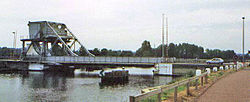
Back Pegasus Bridge Breton Pegasus Bridge Catalan Pegasus Bridge Czech Pegasusbroen Danish Pegasusbrücke German Ponto Pegasus Esperanto Puente Pegasus Spanish Pegasus Bridge French Ponte Pegasus Italian ペガサス橋 Japanese
You can help expand this article with text translated from the corresponding article in French. Click [show] for important translation instructions.
|
Pegasus Bridge | |
|---|---|
 Pegasus Bridge before its replacement | |
| Coordinates | 49°14′32″N 0°16′28″W / 49.24222°N 0.27444°W |
| Crosses | Caen Canal |
| Locale | Bénouville |
| Characteristics | |
| Design | Bascule bridge |
| History | |
| Opened | 1934 |
| Location | |
 | |

Pegasus Bridge, originally called the Bénouville Bridge after the neighbouring village, is a road crossing over the Caen Canal, between Caen and Ouistreham in Normandy. The original bridge, built in 1934, is now a war memorial and is the centrepiece of the Memorial Pegasus museum at nearby Ranville. It was replaced in 1994 by a modern design which, like the old one, is a bascule bridge.
On 6 June 1944, during the Second World War, the bridge was, along with the nearby Ranville Bridge over the Orne River (another road crossing, later renamed Horsa Bridge), the objective of members of D Company, 2nd (Airborne) Battalion, Oxfordshire and Buckinghamshire Light Infantry, a glider-borne force who were part of the 6th Airlanding Brigade of the 6th Airborne Division during Operation Tonga in the opening minutes of the Allied invasion of Normandy. Under the command of Major John Howard, D Company was to land close by the bridges in six Airspeed Horsa gliders and, in a coup-de-main operation, take both intact and hold them until relieved by the main British invasion forces. The successful capture of the bridges played an important role in limiting the effectiveness of a German counter-attack in the aftermath of the Normandy invasion, as did the attack on nearby Merville Gun Battery.
Later in 1944, the Bénouville Bridge was renamed Pegasus Bridge in honour of the operation. The name is derived from the shoulder emblem worn by British airborne forces of I Airborne Corps (United Kingdom), which depicts Bellerophon riding the flying horse Pegasus.
© MMXXIII Rich X Search. We shall prevail. All rights reserved. Rich X Search